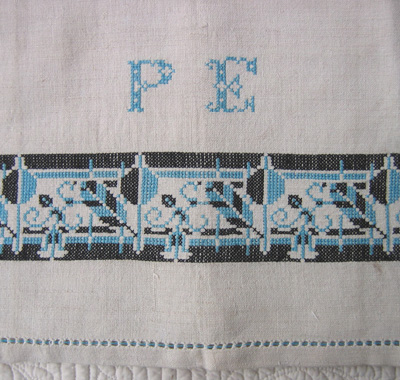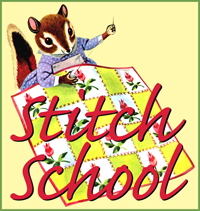"My problem is the hoop marks. How do you avoid having hoop marks on your finished projects?"
I always use the heavy plastic hoops that you can buy now. Hoops used to be made of metal or wood, both of which can be a problem. Metal rusts and can leave spots that likely won't come out. Wood can pick up dirt and, if constructed cheaply, splinter and crack. With plastic, if it gets dirty, you can just wash it off with a sponge and some mild soap. Keeping your hoops clean will help to avoid transfering dirt to your work.
There's a technique for binding a hoop with strips of fabric (cut on the bias), woven cotton tape, or bias binding ironed flat, but this seems to be more about getting a firmer tension between the hoop and your fabric. You do it by separating the two sections of the hoop and wrapping the strip around and around the edge of the bottom (or inside) ring, making sure it doesn't crease and taking a few small stitches when you reach the end to secure everything. I suppose this could work to keep your hoop clean, too, but you'd probably need to wrap both rings.
And don't set your project aside for weeks on end in the hoop. I know, you intend to get right back to it, but will you really? Remove your fabric from the hoop after you're done working for the day and that ring-shaped crease won't have a chance to set in.
I do a lot of stamped embroidery projects and always wash them when I'm finished to get out the stamping. Getting the fabric wet generally takes care of any creasing that occurs while I'm working. If you don't want to wash the entire piece, you could try spraying it with water and ironing the creases out. I keep a spray bottle near my ironing board for this very purpose.
"I am planning an embroidery based on a free print of a chickadee, and I am wondering if a part of the head is black, do I outline it in black? And also when part of the head is white, do I then do that in white? Or do I do it all in black as an outline? Hopefully I didn't confuse you."
I'm pretty sure I know what you mean here, and the problem is really with the white embroidery floss. If you're embroidering on white fabric and using white floss to render a white object, how can you see it against the background? It's personal preference somewhat, but here's what I'd do. If I could use a fabric that had a bit of color in it—like a natural linen—then I'd use white for the part of the head that's white. If I had to use white fabric I'd probably outline with black so it stands out from the background. Even if you outline the whole thing with black, there will be open white areas within the design, giving the illusion that the head is white. Or, I'd use a floss color that's almost but not quite white—ivory, pale gray, or that very pale silvery blue color—all would work for a chickadee.
If this isn't what you meant (and I truly am confused), leave a comment here and I'll explain further.
OK, for you cross stitch lovers, this is a stunning example of art deco design done in black and turquoise on heavy linen. The embroidery is completed in a wide band across the bottom and features two monogrammed letters above it. Flawlessly done. I wouldn't normally pay $17 for a tea towel but this was just too beautiful to walk away from. And no, this will not be cut up for a pillow. I may even frame it!

If you click on the photo there are some closeup photos on my Flickr page. Stop back next week for a new stitch!
















4 comments:
Thanks, You knew exactly what I meant. And I am doing that chickadee on muslin. And I hope to turn the chickadee I am going to do into a quilt patch for a quilt, not exactly like a crazy quilt, but more a random quilt showing off things I love.
Since muslin has a bit of color, white should be fine against it. Your project sounds like fun - and I love chickadees, too. Mine are getting so tame that when their feeder is empty and I'm outside they come and find me and tell me all about it :)
I am going to start on the chickadee today but I started and finished a snowflake on blue cloth yesterday and it has some beginner's flaws but that is what makes it more me. Thanks so much for teaching me these beautiful stitches. A new world has opened up to me.
I don't use a hoop. Is that wrong? When I use a hoop, I tend to push up the fabric to get the needle through. I do have a Q-Snap hoop. Maybe I should pull that out of the attic and try again. Will it make the stitches neater?
Post a Comment